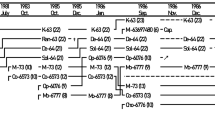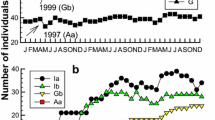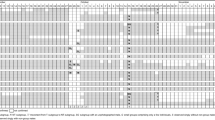Abstract
During the period from June to July 1983, the Hanyama-A troop of wild non-provisioned Japanese monkeys on Yakushima Island began to show signs of troop fission. Adult females together with their infants and juveniles subdivided into two groups, the Hanyama-K group and Hanyama-M group. After the subdivision, all of the troop males were observed vacillating between these two female groups. During the mating season, non-troop males were also observed moving around the two female groups. After this mating season, one of these non-troop males was found to have entered and become the alpha male in one of the groups, while higher-ranking adult males of the original troop settled into the other group. Each fissioned group was strongly considered to be composed of either high-ranking matrilines or low-ranking matrilines as observed previously in provisioned troops. The dominance relation between the two fissioned groups indicated that dominance rank reversal between these two female kin groups must have occurred during the course of subdivision of the troop. However, different from most previous cases of troop fission, there was no indication that males ever participated in the subdivision of the original female group. This was disrupted not as a result of males' involvement, but only as a result of antagonism among females, which initiated the troop fission. The main factor which appeared to determine when and in which fission group males eventually settled was the competition between the troop males' coalition and non-troop males and their ability to monopolize females. The present process of troop fission suggests a dual strategy between males and females (Wrangham, 1979, 1980) even in the society of Japanese macaques.
Similar content being viewed by others
References
Altmann, J., 1974. Observational study of behaviour: sampling methods.Behaviour, 49: 227–267.
Altmann, S. A., 1962. The social behaviour of anthropoid primates: an analysis of some recent concepts. In:Roots of Behaviour,E. L. Bliss (ed.), Hoeber Medical Division of Harper Brothers, New York, pp. 277–285.
Caldecott, J. O., 1983. An ecological study of the pig-tailed macaque in Peninsular Malaysia. Ph.D. thesis, Univ. of Cambridge.
Deag, J. M., 1977. Aggression and submission in monkey societies.Anim. Behav., 25: 465–474.
Dunbar, R. I. M., 1976. Some aspects of research design and their implication in the observational study of behaviour.Behaviour, 58: 78–98.
Fujii, H., 1974. Structure of a natural group of Japanese monkeys at Katsuyama, based on individual relationships.Machikaneyama Ronso, 7: 1–18. (in Japanese)
Fukuda, F., 1982. Relation between age and troop shifting in male Japanese monkeys.Jap. J. Ecol., 32: 491–498. (in Japanese)
Furuichi, T., 1984. Symmetrical patterns in non-agonistic social interaction found in unprovisioned Japanese macaques.J. Ethol., 2: 109–119.
Furuya, Y., 1960. An example of fission of a natural troop of Japanese monkey at Gagyuzan.Primates, 2: 149–180.
, 1968. On the fission of troops of Japanese monkeys. I. Five fissions and social changes between 1955 and 1966 in the Gagyuzan troop.Primates, 9: 323–350.
, 1969. On the fission of troops of Japanese monkeys. II. General view of troop fission of Japanese monkeys.Primates, 10: 47–69.
Itani, J., 1963. Vocal communication of the wild Japanese monkeys.Primates, 4(2): 11–66.
Izawa, K., 1982.Nihonzaru no Seitai (Ecology of Japanese monkeys). Dobutsu-sha, Tokyo. (in Japanese)
, 1984. Group fission of the wild Japanese monkey at Hakusan National Park and its ecological meaning.Report of Investigation, Hakusan Nature Reserve Center, 10: 99–109. (in Japanese)
Kano, K., 1964. The second fission of the natural troop of Japanese monkeys in Takasakiyama. In:Wild Japanese Monkeys in Takasakiyama,J. Itani,J. Ikeda, &T. Tanaka (eds), Keiso-shobo, Tokyo, pp. 42–73. (in Japanese)
Kawamura, S. &M. Kawai, 1956. Social organization of the natural group of Japanese macaque—the case of the Minoo-B group.Jap. J. Ecol., 6(2): 45–50. (in Japanese)
Koyama, N., 1970. Changes in dominance rank and division of a wild Japanese monkey troop in Arashiyama.Primates, 11: 335–390.
Kudo, H., 1984. Dynamics of social relationships in the process of troop formation of Japanese monkeys in Koshima—“working upon” and “impressing behaviour.”J. Anthropol. Soc. Nippon, 92(4): 253–272. (in Japanese)
Maruhashi, T., 1980. Feeding behavior and diet of the Japanese monkey (Macaca fuscata yakui) in Yakushima Island, Japan.Primates, 21: 141–160.
, 1982. An ecological study of troop fissions of Japanese monkeys (Macaca fuscata yakui) on Yakushima Island, Japan.Primates, 23: 317–337.
Nishida, T., 1966. A sociological study of solitary male monkeys.Primates, 7: 141–204.
Nishimura, A., 1973. The third fission of a Japanese monkey group at Takasakiyama. In:Behavioural Regulators of Behaviour in Primates.C. R. Carpenter (ed.), Bucknell Univ. Press, Lewisburg, pp. 115–123.
----, 1977. Group fissions of Japanese monkeys at Takasakiyama, from third to sixth fissions. In:Population Dynamics of Japanese Monkeys at Takasakiyama, Report of the Investigation 1971–1979, Oita City, pp. 37–91. (in Japanese)
Norikoshi, K. &N. Koyama, 1975. Group shifting and social organization among Japanese monkeys. In:Proceed. Symp. 5th Congr. Int. Primatol. Soc.,S. Kondo,M. Kawai,A. Ehara, &S. Kawamura (eds.), Japan Science Press, Tokyo, pp. 43–61.
Rostal, D. C. &G. G. Eaton, 1983. Puberty in male Japanese macaques (Macaca fuscata): social and sexual behaviour in a confined troop.Amer. J. Primatol., 4: 135–141.
Sneath, P. H. A. &R. R. Sokal, 1973.Numerical Taxonomy, The Principal and Practice of Numerical Classification. W. H. Freeman & Co., San Francisco.
Sugiyama, Y., 1960. On the division of a natural troop of Japanese monkeys at Takasakiyama.Primates, 2: 109–148.
, 1976. Life history of male Japanese monkeys. In:Advances in the Study of Behaviour VII,J. S. Rosenblatt &R. A. Hinde (eds.), Academic Press, London, pp. 255–284.
&H. Ohsawa, 1974. Population dynamics of Japanese macaques at Ryozenyama (2) Life history of males. In:Life History of Male Japanese Monkeys—Advances in the Field Studies of Japanese Monkeys, 1,K. Wada,S. Azuma, &Y. Sugiyama (eds.), Primate Research Institute, Kyoto Univ., Inuyama, pp. 55–62. (in Japanese)
Suzuki, A., K. Wada, S. Yoshihiro, E. Tokita, S. Hara, &Y. Aburada, 1975. Population dynamics and group movement of Japanese monkeys in Yokoyugawa Valley, Shiga Heights.Physiol. Ecol. Japan, 16: 15–23. (in Japanese)
Tagawa, H., 1980. Vegetation on the western slope of Mt. Kuniwaridake, Yakushima Island.Sci. Rep. Kagoshima Univ., 29: 121–137. (in Japanese)
Takizawa, H., 1983. Subgrouping in Japanese monkeys—A case study on Kamuri-A troop. Unpublished master's thesis, Kanazawa Univ. (in Japanese)
Tokita, E., 1980. The fission of Shiga-A troop of Japanese monkeys.Nat. & Anim., 10: 26–30. (in Japanese)
Whitten, P. L., 1981. Fissions and fusions in vervet monkey (Cercopithecus aethiops) troops.Amer. J. Phys. Anthropol., 54: 290.
Wrangham, R. W., 1979. On the evolution of ape social systems.Social Science Information, 18: 335–368.
, 1980. An ecological model of female-bonded primate groups.Behaviour, 73: 262–299.
Yamada, M., 1963. A study of blood-relationship in the natural society of the Japanese macaque—an analysis of co-feeding, grooming, and playmate relationship in Minoo-B troop.Primates, 4(3): 43–65.
Yamagiwa, J., 1979. Some external characters of the Japanese monkeys (Macaca fuscata).J. Anthropol. Soc. Nippon, 87: 483–498. (in Japanese)
, 1985. Socio-sexual factors of troop fission in wild Japanese monkeys (Macaca fuscata yakui) on Yakushima island, Japan.Primates, 26: 105–120.
Author information
Authors and Affiliations
About this article
Cite this article
Oi, T. Sociological study on the troop fission of wild. Primates 29, 1–19 (1988). https://doi.org/10.1007/BF02380846
Received:
Accepted:
Issue Date:
DOI: https://doi.org/10.1007/BF02380846




